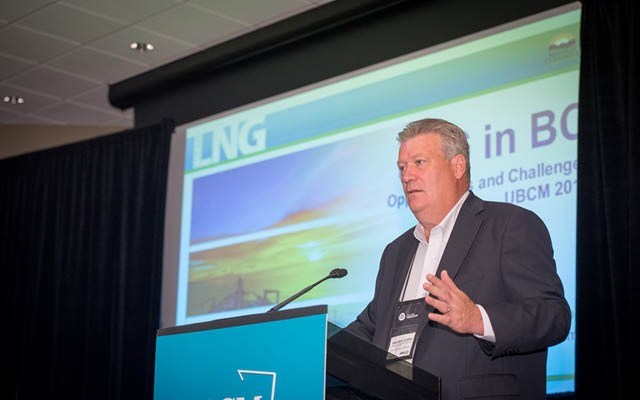With over 2,000 delegates in Whistler this week for the annual Union of British Columbia Municipalities (UBCM) Convention, members of the community activist group My Sea to Sky felt like the public's voice was conspicuously missing from the conversation around one of the most controversial issues in provincial history: LNG.
So, the Squamish-based volunteer group decided to bring their voice directly to the province's decision makers Wednesday, Sept. 24, staging a rally at a reception organized by the B.C. Government.
"I wouldn't say it's a protest," said My Sea to Sky representative Auli Parviainen. "What it is, is an expression of people saying, 'We matter and we should have a meaningful vote in making this decision.'"
My Sea to Sky has been a vocal opponent of Woodfibre LNG's proposal to develop a liquefied natural gas export facility on Howe Sound, and has contacted UBCM Convention attendees to keep the issue on the forefront of delegates' minds.
"One of the concerns we have is that the public expression and any public interest seems to be completely missing from the participation at UBCM," Parviainen said. "If you look at the sponsors of the conference, you see that they're all from the mining, oil and gas industry. There are also lobby groups on behalf of the industry that are participating. Our concern is that the agenda is quite biased towards the oil and gas industry."
Of the 40-plus sponsors for this year's convention, a number have interests in Canada's natural gas, resource and oil industries, including LNG Canada, the Canadian Association of Petroleum Producers, the Canadian Energy Pipeline Association, China's Consulate General in Vancouver, and Imperial Metals, owners of the Mount Polley copper and gold mine that was the site last month of a major slurry spill that has been called one of the worst environmental disasters in modern Canadian history.
Parviainen was also critical of B.C. Minister of Natural Gas Development Rich Coleman's warning to municipal leaders against hefty industrial taxes for LNG plants while speaking at the convention Monday, Sept. 22.
With a potential $175-billion in industry investment on the table, Coleman said he doesn't want local governments' industrial tax rates to scare off the LNG sector.
"It's not about capping, it is about making sure we don't make a mistake where... once we have a plant in a jurisdiction where somebody has made a multi-billion investment that (the municipality) thinks they can pile on a bunch of other costs that are unfair," he said, stopping short of calling for a municipal cap on LNG industry taxes.
In a July letter to the District of Squamish, Woodfibre LNG requested the municipality set a $2-million property tax agreement for the export facility that would increase annually with inflation to a maximum cap of $3 million. Since then, Woodfibre said the proposal was only a rough estimate meant to spur discussion, and that it was still too early to predict a final number.
"Woodfibre LNG put forth a proposal in July that the tax rate would be set at $2 million, which is the rate that the (former) Woodfibre pulp mill paid in 2006," Parviainen said. "If you were to tie that into property taxes across the board, it would be incredibly inadequate."
LNG Canada's general manager, Susannah Pierce, also cautioned officials Monday at the UBCM session of the risks associated with setting industrial tax rates too high, saying there needs to be "a limited tax take by all four levels of government" in order to be competitive in the global LNG market.
"It doesn't mean that we shouldn't pay our fair share to make sure the municipality has what it needs to support us," she said. "We will be using infrastructure, we will be using city services, and to the extent that we are, we need to be able to pay for that.
"Our challenge is to make sure we're cost-competitive and that our customers in Asia are willing to buy our gas at that cost."
But for local government leaders in communities that stand to be most directly impacted by the sudden windfall of industry investment, there are concerns over their ability to withstand the LNG rush and its associated costs.
In Kitimat, where officials are considering a number of LNG proposals, there are questions over who should bear the brunt of the costs to handle a population that could potentially double if developments from LNG Canada and Chevron go ahead.
"We can paint a very nice picture that when we set a tax rate to industry, it's fully understood that they'll be part of it," said Kitimat's chief administrator Ron Poole. "I don't think it's fair that the province feels it needs to put a cap on municipalities."
Convention delegates will consider a resolution this week that UBCM urge Victoria to refrain from considering or implementing a tax cap for industrial properties related to the LNG industry.
The UBCM Convention closes Friday, Sept. 26.




